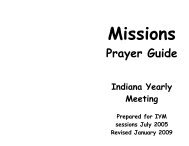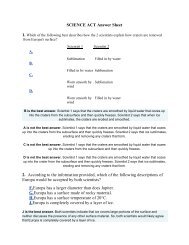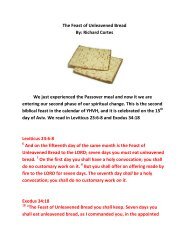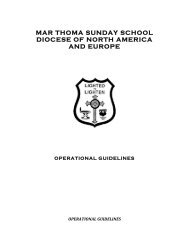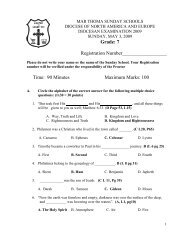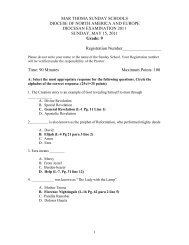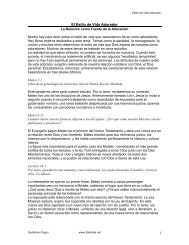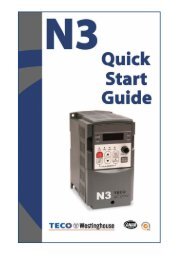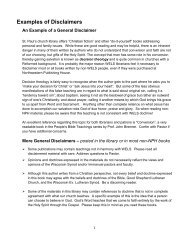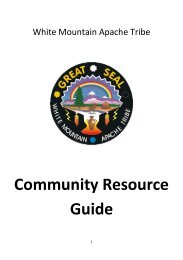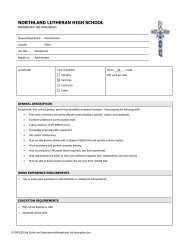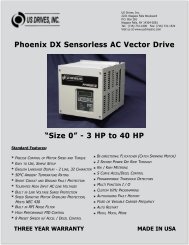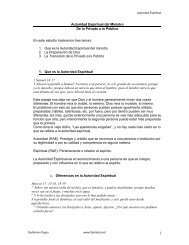AP Calculus
AP Calculus
AP Calculus
Create successful ePaper yourself
Turn your PDF publications into a flip-book with our unique Google optimized e-Paper software.
<strong>AP</strong> <strong>Calculus</strong><br />
Course Description<br />
At the high school level, <strong>AP</strong> <strong>Calculus</strong> will be the culmination of your mathematics training. There<br />
are limitations to what can be accomplished with algebra and geometry. With concepts you will<br />
learn in <strong>AP</strong> <strong>Calculus</strong>, the derivative and the integral, many new doors will be opened to you as to<br />
what you can do with mathematics. Your training in algebra and geometry will provide you the<br />
necessary skills to help you pass through those doors.<br />
Course Objectives<br />
The student will<br />
<br />
<br />
<br />
<br />
<br />
<br />
<br />
<br />
Review material from previous coursework essential for the study of calculus.<br />
Learn the concept of limit, the underlying concept in calculus.<br />
Learn and study the connection between slope and speed and other quantities of interest.<br />
Learn to graph and analyze complicated functions as well as solve equations involving these<br />
functions.<br />
Explore the relationships among problems involving finding a function from its derivative,<br />
finding the average value of a function and finding the area under a curve and learn a<br />
variety of techniques for solving them.<br />
Discover the versatility of the integral by exploring numerous applications.<br />
Learn new techniques of integration which provide a broad range of tools used to solve<br />
countless problems of interest to engineers, mathematicians and scientists.<br />
Learn the basic theory and a few common applications of some elementary differential<br />
equations.<br />
Primary Textbook<br />
Smith and Minton. <strong>Calculus</strong> – Early Transcendental Functions. Third Edition. McGraw Hill,<br />
2007.<br />
Technology Requirement<br />
Texas Instruments 84 Plus. We will use the calculator in a many different ways, including:<br />
<br />
<br />
<br />
<br />
<br />
Conducting explorations<br />
Graphing functions<br />
Solving equations numerically<br />
Analyzing and interpreting results<br />
Justifying and explaining results of graph and equations
Student Evaluation<br />
As a part of the evaluation process students will be assigned problems which will require them<br />
to explain or justify solutions using well-written sentences. Each unit will have one or two exams<br />
based upon the amount of material presented. Occasionally included in these exams will be<br />
examples of free-response and multiple-choice questions similar to what the student will<br />
encounter on the <strong>AP</strong> exam. There also will be a semester one final.<br />
Unit 1 : Limits and Continuity (approximately 4 weeks)<br />
A. Student Activity – How Many Fish in the Lake<br />
This activity is designed to introduce students to the idea of a numerical limit and to<br />
help them become more familiar with some of the features of their calculators. With<br />
the number of fish decreasing annually by 20%, students will construct tables to find<br />
if the number of fish stabilize when the lake is restocked with varying numbers of fish<br />
each year. Also, they will be asked which levels of restocking allow the number of fish<br />
to reach a desired level. Students will be asked to explain their solution in complete, wellwritten<br />
sentences.<br />
B. The Concept of Limit (including one-sided limits)<br />
1. Determining Limits Graphically<br />
2. Determining Limits Numerically<br />
C. Computation of Limits (including one-sided limits)<br />
1. Finding Limits Using Algebra<br />
2. The Squeeze Theorem<br />
3. Limit of a Piecewise Function<br />
D. Continuity and its Consequences<br />
1. Point, Jump and Infinite Discontinuity<br />
2. Continuous Functions<br />
3. Intermediate Value Theorem<br />
E. Limits Involving Infinity<br />
1. Asymptotes<br />
a. Vertical<br />
b. Horizontal<br />
c. Slant<br />
2. Limits at Infinity
F. Student Activity – Order of Magnitude of a Function<br />
This activity demonstrates the relative order of magnitude between two functions using<br />
a limit of the ratio of the two. Students, using their graphing calculators, will use both<br />
graphical and numerical modes to view the problem. Using different pairs of functions;<br />
some exponential, some logarithmic and some polynomial; the students will be asked to<br />
list these types of functions in order of increasing magnitude.<br />
Unit 2 : Differentiation (approximately 6 weeks)<br />
A. Tangent Lines and Velocity<br />
B. Derivative<br />
1. Tangent Line to a Point on a Curve<br />
2. Difference Quotient<br />
3. Graphical and Numerical Approximation of the Slope of a Tangent Line<br />
4. Student Activity – The 20 Minute Ride<br />
This activity is designed to help students see the need for an instantaneous rate<br />
of change, which is the derivative. Using their calculators, the students will<br />
complete a table which relates time and distance. The data for this table will be<br />
distance traveled (to the nearest 0.1 mile) at the end of each minute during a 20<br />
minute car ride. They will then graph a scatter plot from which they will see the<br />
relationship between a distance function and its first derivative (velocity). The<br />
students will also calculate average velocity during smaller and smaller time<br />
intervals leading to the concept of instantaneous velocity.<br />
5. Average and Instantaneous Velocity<br />
6. Derivatives as a Rate of Change<br />
1. Derivative as the Limit of the Difference Quotient<br />
2. Differentiability and Continuity<br />
3. Relationship Between the Graphs of f and f’<br />
4. Alternative Derivative Notations<br />
5. Numerical Differentiation<br />
C. Computation of Derivatives : The Power Rule<br />
1. Power Rule
2. General Derivative Rules<br />
a. Sum<br />
b. Difference<br />
c. Multiplying by a Constant<br />
3. Higher Order Derivatives<br />
4. Acceleration<br />
D. Product and Quotient Rules<br />
1. Product<br />
2. Quotient<br />
3. Applications<br />
E. Chain Rule<br />
F. Derivatives of Trigonometric Functions and Applications<br />
1. Derivatives of the Six Trigonometric Functions<br />
2. Applications<br />
a. Spring-Mass System<br />
b. Simple Electrical Circuit<br />
3. Equation of a Tangent Line<br />
G. Derivatives of Exponential and Logarithmic Functions<br />
1. Exponential Function<br />
2. Natural Logarithm<br />
3. Logarithmic Differentiation<br />
H. Implicit Differentiation<br />
1. First and Second Derivatives Found Implicitly<br />
2. Derivatives of the Inverse Trigonometric Functions<br />
I. Mean Value Theorem<br />
1. Rolle’s Theorem<br />
2. Mean Value Theorem
3. Increasing and Decreasing Functions<br />
Unit 3 : Applications of Differentiation (approximately 5 weeks)<br />
A. Linear Approximations<br />
B. Maximum and Minimum Values<br />
1. Extreme Value Theorem<br />
2. Absolute vs. Local Extrema<br />
3. Definition of a Critical Number<br />
C. Increasing and Decreasing Functions<br />
1. Relationship of the Derivative to the Graph of a Function<br />
2. First Derivative Test<br />
3. Curve Sketching<br />
D. Concavity and the Second Derivative Test<br />
1. Second Derivative and Concavity<br />
2. Inflection Points<br />
3. Second Derivative Test<br />
4. Curve Sketching<br />
5. Student Activity – Reasoning from a Graph<br />
This activity is a card matching game. Color coded cards are provided to the<br />
students. One color card displays a function. Another color, a verbal description<br />
of the graph of that function. Yet another, the graph of the given function.<br />
Finally, third and fourth color cards display the graph of the first and second<br />
derivative of said function. The students will play various matching games<br />
helping them to see the relationship between functions and their derivatives.<br />
E. Overview of Curve Sketching<br />
F. Optimization<br />
G. Related Rates<br />
H. Rates of Change in Economics and the Sciences
Unit 4 : Integration (approximately 5 weeks)<br />
A. Antiderivatives<br />
1. Indefinite Integral<br />
2. Power Rule<br />
3. Sums and Differences<br />
B. Sums and Sigma Notation<br />
C. Area<br />
1. Approximating Area with Rectangles<br />
2. Computing Area Exactly<br />
3. Riemann Sum<br />
a. Left Evaluation Point<br />
b. Right Evaluation Point<br />
c. Midpoint Evaluation Point<br />
4. Student Activity – Another 20 Minute Ride<br />
D. Definite Integral<br />
Student data gathered earlier in the year for the activity “20 Minute Ride”<br />
may be used once again for this activity. This activity is designed to show<br />
the students a practical application of Riemann sums. The definite<br />
integral has more applications than simply area under a curve. Through<br />
questioning the students will be led to see that the definite integral can be<br />
used as an accumulator to lead to better and better approximations for<br />
distance traveled.<br />
1. Using Riemann Sums to Compute a Definite Integral<br />
2. Signed vs. Total Area<br />
3. Student Activity – What’s an Accumulator<br />
Yet another activity designed to reinforce the concept of the definite<br />
integral as an accumulator. Students will be asked to sketch graphs<br />
dealing with topics such as daily television set sales, velocity, high school<br />
graduates, birth rate, price of a cup of coffee and rate of change of<br />
temperature; write Riemann sums for the given relationships and write a<br />
definite integral to represent the relationship.<br />
4. Average Value of a Function
5. Integral Mean Value Theorem<br />
E. Fundamental Theorem of <strong>Calculus</strong><br />
1. Part 1<br />
2. Part 2<br />
F. Integration by Substitution<br />
1. Indefinite Integrals<br />
2. Definite Integrals<br />
G. Numerical Integration<br />
1. Midpoint Rule<br />
2. Trapezoidal Rule<br />
3. Estimating an Integral from a Table of Function Values<br />
H. Natural Logarithm as an Integral<br />
1. Properties of Logarithms<br />
2. Logarithmic Differentiation<br />
3. Exponential Function<br />
Unit 5 : Applications of the Definite Integral (approximately 5 weeks)<br />
A. Area Between Curves<br />
1. Integrating with Respect to x<br />
2. Integrating with Respect to y<br />
B. Volume : Slicing, Disks and Washers<br />
1. Slicing<br />
2. Disks<br />
3. Washers<br />
C. Projectile Motion<br />
D. Applications of Integration to Physics and Engineering<br />
1. Work<br />
2. Impulse<br />
3. Mass
4. Hydrostatic Force<br />
E. Probability<br />
1. Probability Density Function<br />
2. Mean and Median<br />
Unit 6 : Integration Techniques (approximately 3 weeks)<br />
A. Review of Formulas and Techniques<br />
B. Trigonometric Techniques of Integration<br />
1. u Substitution<br />
2. Trigonometric Substitution<br />
Unit 7 : First-Order Differential Equations (approximately 2 weeks)<br />
A. Modeling with Differential Equations<br />
1. Growth and Decay Problems<br />
2. Compound Interest<br />
B. Separable Differential Equations<br />
1. Solving Separable Differential Equations<br />
2. Initial Value Problems<br />
C. Slope Fields<br />
1. Constructing Slope Fields<br />
2. Using a Slope Field to Visualize the Behavior of Solutions<br />
Unit 8 : Review and Test Preparation (approximately 4 weeks)<br />
A. Multiple-Choice Practice<br />
B. Free-Response Practice<br />
Unit 9 : Non <strong>AP</strong> Topics (approximately 2 weeks)<br />
A. L’Hôpital’s Rule<br />
B. Simpson’s Rule<br />
C. Integration by Parts



